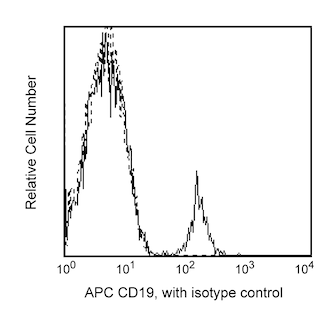-
Your selected country is
Middle East / Africa
- Change country/language
Old Browser
This page has been recently translated and is available in French now.
Looks like you're visiting us from {countryName}.
Would you like to stay on the current country site or be switched to your country?


.png)

Two-color flow cytometric analysis of CD307a (FCRL1) expression on human peripheral blood lymphocytes. Human peripheral blood was stained with APC Mouse Anti-Human CD19 antibody (Cat. No. 555415) and either PE Mouse IgG1, κ Isotype Control (Cat. No. 554680; Left Plot) or PE Mouse Anti-Human CD307a (FCRL1) antibody (Cat. No. 566457; Right Plot). Erythrocytes were lysed with BD Pharm Lyse™ Lysing Buffer (Cat. No. 555899). Two-color contour plots showing the correlated expression of CD19 versus CD307a (FCRL1) [Ig Isotype control staining] were derived from gated events with the forward and side light-scatter characteristics of intact lymphocytes. Flow cytometric analysis was performed using a BD LSRFortessa™ X-20 Cell Analyzer System..
.png)

BD Pharmingen™ PE Mouse Anti-Human CD307a (FCRL1)
.png)
Regulatory Status Legend
Any use of products other than the permitted use without the express written authorization of Becton, Dickinson and Company is strictly prohibited.
Preparation And Storage
Product Notices
- Since applications vary, each investigator should titrate the reagent to obtain optimal results.
- An isotype control should be used at the same concentration as the antibody of interest.
- Source of all serum proteins is from USDA inspected abattoirs located in the United States.
- Caution: Sodium azide yields highly toxic hydrazoic acid under acidic conditions. Dilute azide compounds in running water before discarding to avoid accumulation of potentially explosive deposits in plumbing.
- For fluorochrome spectra and suitable instrument settings, please refer to our Multicolor Flow Cytometry web page at www.bdbiosciences.com/colors.
- Please refer to www.bdbiosciences.com/us/s/resources for technical protocols.
Companion Products






The E3 monoclonal antibody specifically recognizes CD307a which is also known as Fc receptor-like protein 1 (FCRL1), Fc receptor homolog 1 (FCRH1), or Immune receptor translocation-associated protein 5 (IRTA5). CD307a (FCRL1) is a type I transmembrane glycoprotein that belongs to the IRTA gene family within the Ig gene superfamily. It has three extracellular Ig-like domains, a glutamic acid residue in its transmembrane region, and two consensus immunoreceptor tyrosine-based activation motifs (ITAMs) in its cytoplasmic domain. CD307a (FCRL1) bears sequence homology to classical Fc receptors. CD307a (FCRL1) is first expressed on pre-B cells and increases with maturation being expressed on naïve and memory B cells. It is downregulated by activated germinal center (GC) B cells. It may also be expressed by B cell-derived leukemia and lymphoma cells. CD307a may play key roles in B cell activation, differentiation and effector functions.

Development References (3)
-
Du X, Nagata S, Ise T, Stetler-Stevenson M, Pastan I. FCRL1 on chronic lymphocytic leukemia, hairy cell leukemia, and B-cell non-Hodgkin lymphoma as a target of immunotoxins.. Blood. 2008; 111(1):338-43. (Immunogen: Cytotoxicity, Flow cytometry, Functional assay). View Reference
-
Llinas L, Lazaro A, de Salort J, Matesanz-Isabel J, Sintes J, Engel P. Expression profiles of novel cell surface molecules on B-cell subsets and plasma cells as analyzed by flow cytometry. Immunol Lett. 2011; 134(2):113-121. (Biology). View Reference
-
Matesanz-Isabel J, Sintes J, Llinas L, de Salort J, Lazaro A, Engel P. New B-cell CD molecules. Immunol Lett. 2011; 134(2):104-112. (Biology). View Reference
Please refer to Support Documents for Quality Certificates
Global - Refer to manufacturer's instructions for use and related User Manuals and Technical data sheets before using this products as described
Comparisons, where applicable, are made against older BD Technology, manual methods or are general performance claims. Comparisons are not made against non-BD technologies, unless otherwise noted.
For Research Use Only. Not for use in diagnostic or therapeutic procedures.
Report a Site Issue
This form is intended to help us improve our website experience. For other support, please visit our Contact Us page.